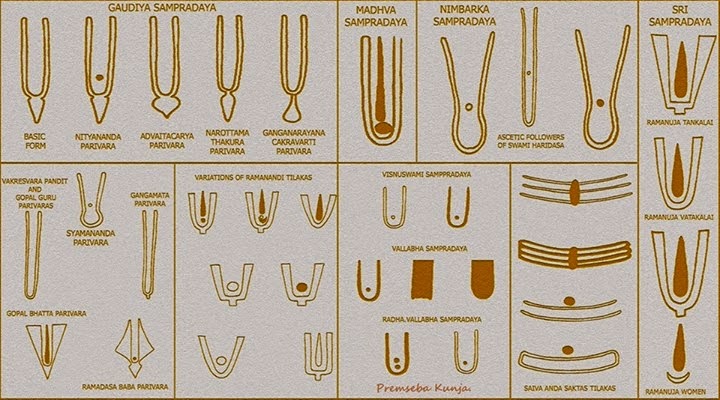Why Do We Wear Tilak, Pottu On The Forehead

Tilak or Tilaka, तिलक is the mark of Hindu identity worn on the forehead made with Chandan or sandalpaste, roli, kumkum, sindoor, and sacred ash or Vibhuti with additional few grains of rice stuck on it.
Tilak is a religious mark that can be worn on daily basis or for special religious occasions. Its form and color may vary according to one’s caste, religious sect or the form of the Lord worshiped.
Some Tilak appears as three lines of ash going horizontally across the forehead that indicates one is a Shaivite, or a small triangle on the nose with a “V” shape rising vertically up on the forehead from between the eyebrows, which indicates one is a Vaishnava.
The forehead signifies spirituality, hence a Tilak is to be applied at the place between two eyes on the forehead. That particular place is a ‘Marma’ sthan or a critical point. It is a place called ‘Aajnaa chakra‘ or ‘command circle“.
Tilak is applied at the Ajna Chakra has a very cooling effect. The application of sandal paste has great medicinal value, apart from the spiritual influence. The application of sandal paste will nullify the heating effect when you concentrate and meditate at the Bhrumadhya.
There are 5 types of Tilaks. They are Chandan(Sandelwood) Tilak, Sindoor tilak, Kumkum Tilak, Haldi(Turmeric) Tilak, Bhasma(Ash) Tilak. The color of the tilak is said to denote different castes like Brahmana, Kshatriya, Vaishya, and Sudra.
The Brahmin applied a white Chandan mark signifying purity, as his profession was of a priestly or academic nature. The Kshatriya applied a red kumkum mark signifying valor as he belonged to the warrior race. The Vaishya wore a yellow kesar or turmeric mark signifying prosperity as he was a businessman or trader devoted to the creation of wealth. The Sudra applied a black bhasma, kasturi or charcoal mark signifying service as he supported the work of the other three castes.
The shape of the tilak also denotes the deity one worships. Vishnu worshippers apply a Chandan (sandalwood) tilak of the shape of “U”, Shiva worshippers, a Tripundra (of the shape of “º”) of bhasma; Devi worshippers a red dot of kumkum, and so on.
The Tilak is applied with the prayer – “May I remember the Lord. May this pious feeling pervade all my activities. May I be righteous in my deeds.” Even when we temporarily forget this prayerful attitude, the mark on another reminds us of our resolve. The tilak is thus a blessing of the Lord and a protection against wrong tendencies and forces.
The scientific significance of applying Tilak on the forehead:-
1. Our body emits energy in the form of electromagnetic waves and especially the forehead and the subtle spot between the eyebrows.
2. The Tilak cools the forehead, protects us, and prevents the loss of energy. Even sometimes we used to apply sandalwood paste on the entire forehead to keep the forehead cool.
3. In kumkum (vermilion), mercuric sulfide is the main compound and it reduces stress and fatigue.
4. In turmeric, has 18 nutrients of the soil and the important being iron, hence when applied on the forehead it regulates your body’s aura and eliminates the negative energy, and promotes good health.
5. Bhasma is calcinated , it protects the body from free radical damage.
Suggested Read: Significance Of Mauli (Kalava)






